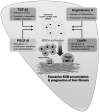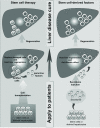Current Understanding of Stem Cell and Secretome Therapies in Liver Diseases
- PMID: 30603518
- PMCID: PMC6171672
- DOI: 10.1007/s13770-017-0093-7
Current Understanding of Stem Cell and Secretome Therapies in Liver Diseases
Abstract
Liver failure is one of the main risks of death worldwide, and it originates from repetitive injuries and inflammations of liver tissues, which finally leads to the liver cirrhosis or cancer. Currently, liver transplantation is the only effective treatment for the liver diseases although it has a limitation due to donor scarcity. Alternatively, cell therapy to regenerate and reconstruct the damaged liver has been suggested to overcome the current limitation of liver disease cures. Several transplantable cell types could be utilized for recovering liver functions in injured liver, including bone marrow cells, mesenchymal stem cells, hematopoietic stem cells, macrophages, and stem cell-derived hepatocytes. Furthermore, paracrine effects of transplanted cells have been suggested as a new paradigm for liver disease cures, and this application would be a new strategy to cure liver failures. Therefore, here we reviewed the current status and challenges of therapy using stem cells for liver disease treatments.
Keywords: Liver failure; Liver regeneration; Secretome; Stem cell transplantation.
Conflict of interest statement
The authors declare that they have no competing interests.This review article does not contain any studies with human or animal subjects performed by any of the authors.
Figures


References
Publication types
LinkOut - more resources
Full Text Sources
Other Literature Sources
